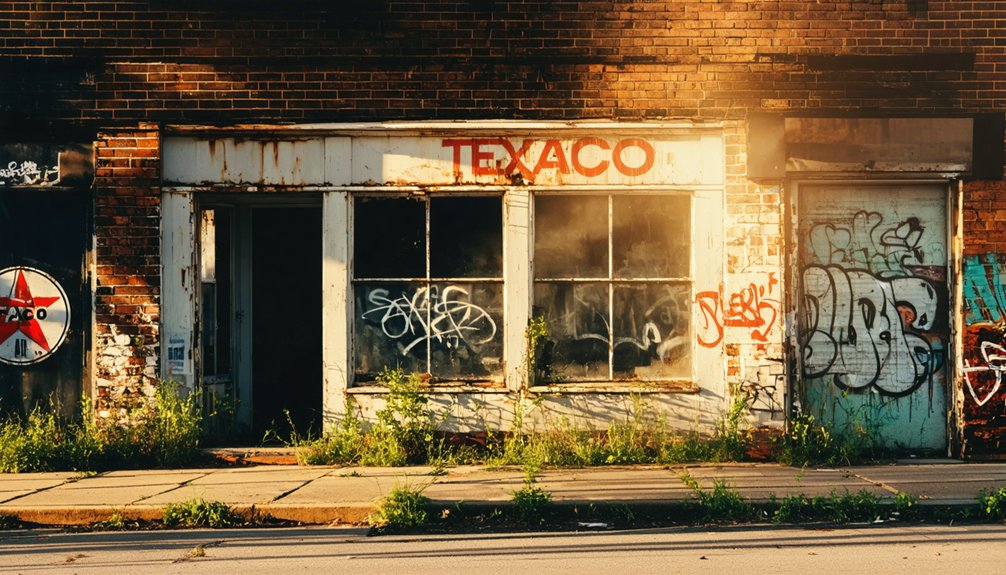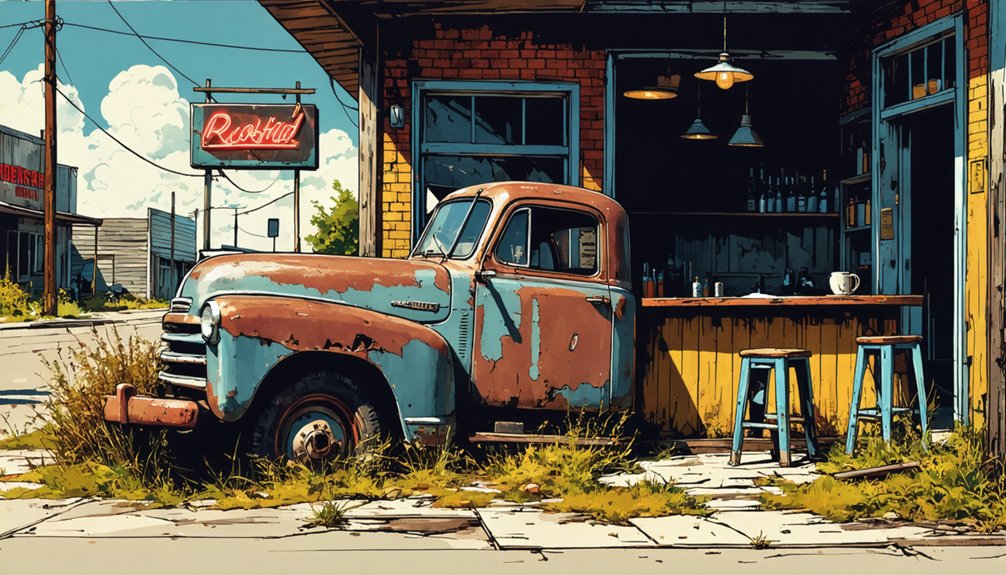You’ll find two towns named Mesquite in Texas, but don’t confuse them. While Dallas County’s Mesquite thrives today with 150,000 residents, Borden County’s Mesquite stands as a silent ghost town, abandoned after failed agricultural dreams. Founded in 1873 along the Texas and Pacific Railway, the ghost town tells a story of overgrazing, invasive brush, and declining farms. Its empty buildings and quiet streets hold tales of pioneer hopes and historic mysteries.
Key Takeaways
- Mesquite in Borden County, Texas became a ghost town after agricultural decline, while its Dallas County namesake grew into a thriving suburb.
- Abandoned agricultural plots and declining soil conditions led to accelerated farm abandonment and rural depopulation in the Mesquite area.
- Texas lost nearly 250,000 farms, with farmland disappearing at 887 acres per day due to economic pressures and aging farmer populations.
- Old Hollomon Road in Mesquite features abandoned structures and is known for murder mysteries and urban legends.
- The region’s ghost town elements are preserved through historical sites like Opal Lawrence Historical Park and Florence Ranch Homestead.
The Tale of Two Mesquites: Dallas vs. Borden County
While Texas boasts many towns named after its native mesquite trees, two settlements sharing this name tell dramatically different stories.
From thorny tree to town name, mesquite’s legacy in Texas sprouted two settlements with radically different destinies.
You’ll find Mesquite, Dallas County, thriving as a symbol of successful urban development, growing from an 1873 railway depot into a bustling suburb of over 150,000 residents. The town was established by the Texas and Pacific Railway. The town’s transformation from cotton fields to modern retail and industrial sectors showcases the American dream of progress. Under the leadership of first mayor Russell, the community began establishing its identity as an incorporated town in 1888.
In stark contrast, you’ll discover Mesquite in Borden County stands as a ghost town, its hopes of agricultural prosperity long faded.
These Mesquite comparisons highlight the unpredictable nature of settlement success in Texas. While one became a cultural hub hosting championship rodeos and festivals, the other succumbed to ghost town dynamics, serving as a quiet reminder of the state’s ever-changing landscape.
Early Railroad Settlement and Development
The story of Mesquite’s railroad beginnings takes us back to May 22, 1873, when Texas & Pacific Railroad Agent A.R. Alcott filed the first plat for this prairie settlement.
His vision of railroad expansion shaped the early commerce of this frontier town, transforming open grassland into a bustling depot community.
A notable resident, Major William Bradfield, completed construction of his residence at the intersection of West Davis and Ebrite Streets during the town’s founding year.
The land was a central gathering place for indigenous trading groups who inhabited the area before settlers arrived.
You’ll discover how Mesquite’s original footprint emerged from 50 acres of possibility, with key features that defined its character:
- A rough-sawn pine depot with livestock pens that anchored agricultural trade
- Front Street’s wooden structures, including blacksmith shops and saloons
- The crucial rail connection between Texarkana and Fort Worth
- A thriving agricultural hub that drew settlers seeking opportunity
The Sam Bass Train Robbery Legacy
Notorious outlaw Sam Bass and his gang left an indelible mark on Mesquite’s history through their daring train robberies in 1878. The outlaws staged another successful heist at Mesquite on April 10th, making it their final Texas railway raid.
You’ll find their most infamous raid targeted the Texas and Pacific Express, where they killed Deputy Sheriff Grimes and wounded Deputy Moore. The violence of this robbery sparked the legendary “Bass War,” with Texas Rangers under Captain Lee Hall relentlessly pursuing the outlaws across the state.
The gang’s key members included Frank Jackson, Seaborn Barnes, and Jim Murphy, whose ultimate betrayal led to Bass’s downfall. Murphy’s betrayal came after intense pressure from General Jones’s persuasion.
Like so many outlaw gangs before them, Bass’s crew was ultimately undone by the treachery of one of their own.
After multiple skirmishes and near-captures, the outlaw legacy came to a violent end in Round Rock, where Bass fell in a shootout with lawmen. He died two days later on his 27th birthday, but his story lives on in Texas folklore.
Haunted Tales of Old Hollomon Road
Following Sam Bass’s violent legacy, Old Holloman Road emerged as Mesquite’s most notorious haunted location after a chilling murder mystery in the 1980s. When a young mother and son were found dead there, the road’s already sinister reputation deepened into something far more menacing. In 2003, justice was finally served when the abductor received life in prison.
Dense trees and isolation created the perfect backdrop for urban legends that still echo today. Today, the area is almost unrecognizable as new construction transforms the landscape.
- Local teens dared each other to bike through, often reporting feelings of being pursued
- Paranormal investigators documented strange noises and an old man’s apparition in rags
- A solitary house along the road became central to countless ghost stories
- Geocaching enthusiasts now preserve the road’s dark history through a 12-cache haunted trail
Despite ongoing construction threatening to erase its existence, Old Holloman’s haunted tales continue to captivate thrill-seekers and paranormal investigators alike.
Historical Landmarks and Architecture
You’ll find tangible links to Mesquite’s pioneer past in the Opal Lawrence Historical Park and Florence Ranch Homestead, where Texas prairie vernacular architecture showcases the resourcefulness of early settlers.
Downtown’s brick buildings, including remnants of the Dallas Pressed Brick Company site, tell stories of the city’s industrial growth and cultural evolution. Both historic properties are Texas Recorded Landmarks that exemplify the region’s architectural heritage. The Florence Ranch began as a 207.5 acre homestead established by David W. Florence in the early 1870s.
These preserved structures, from simple farmsteads to commercial buildings, stand as a testament to the determination of Mesquite’s founding families who shaped the architectural landscape you see today.
Preserved Pioneer Buildings
Two remarkable pioneer homesteads stand as monuments to Mesquite’s early settler history: the Opal Lawrence Historical Park and Florence Ranch Homestead.
These sites offer you a rare glimpse into Texas pioneer heritage through authentic preservation of 1870s architecture and lifestyle.
At these historical preservation sites, you’ll discover:
- The Lawrence house, built in 1874, featuring original painted and stenciled ceilings that showcase pioneer artistic expression
- Florence Ranch, predating Mesquite itself, restored to its 1890 condition with authentic family furnishings
- A 13.8-acre park where the Lawrence family lived continuously until 1995
- Living history through educational tours at Florence Ranch, managed by Historic Mesquite, Inc.
Both properties represent true Texas prairie vernacular style, constructed with local materials and embodying the independent spirit of early settlers.
Downtown Brick Architecture
Beyond the preserved pioneer homesteads, Mesquite’s downtown brick architecture stands as a tribute to the town’s early industrial growth.
You’ll see the architectural evolution that began in the early 1900s when the Dallas Pressed Brick Company transformed the town’s wooden structures into more permanent brick buildings.
Walking through downtown, you’ll notice distinctive brick facades featuring decorative corbelling, patterned courses, and large storefront windows that showcase the craftsmanship of the era.
The buildings’ orientations shifted from Front Street to face a central town square, creating a more community-focused layout.
While exploring these historic commercial blocks, you’ll spot characteristic elements like parapets, recessed entrances, and transom windows – all evidence of Texas’s small-town vernacular architecture of the late 19th and early 20th centuries.
Rural Life and Agricultural Decline
You’ll see clear signs of rural decay in Mesquite’s once-thriving farmlands, where overgrazing and mesquite invasion transformed productive grasslands into deteriorating pastures.
If you’d traveled these roads in the late 1800s, you’d have witnessed bustling farms and ranches supported by the Texas and Pacific Railroad’s agricultural shipping routes.
Today, you’ll find abandoned agricultural plots where declining soil conditions and invasive brush forced many farming families to abandon their traditional way of life.
Farm Life Fades Away
While Texas once boasted nearly a quarter-million farms, the agricultural landscape around Mesquite has changed dramatically in recent years.
You’ll find farm abandonment and rural depopulation accelerating as economic pressures mount and water resources dwindle. The Ogallala Aquifer’s steady depletion threatens the very foundation of farming life, while rising costs push more families off their land.
- Farms are disappearing at a rate of 887 acres per day across Texas
- Labor costs have jumped 17%, while property taxes surged 25%
- The aging farmer population isn’t being replaced by younger generations
- Critical water sources are running dry, making sustainable farming impossible
What you’re witnessing is the sunset of an era, as croplands and pastures give way to urban development, forever changing the face of Mesquite’s rural heritage.
Ranches Become Empty Land
As the twentieth century progressed, Mesquite’s once-thriving ranches transformed into vacant plots and historical remnants.
You’ll find that iconic properties like Florence Ranch, which once sprawled across 700 acres of stock farming and prairie hay fields, succumbed to the pressures of eminent domain and declining agricultural profits.
The ranch decline left scattered empty buildings where vibrant farming communities once stood.
Today, you’ll discover only traces of this agricultural heritage in places like Opal Lawrence Historical Park, where 13 acres preserve 19th-century farm structures.
Where cattle once grazed and crops flourished, historical preservation efforts now maintain memories of rural life.
The construction of Joe Pool Lake and urban expansion claimed additional farmland, leaving behind quiet testimony to Mesquite’s ranching legacy.
Modern Heritage and Cultural Tourism

Despite its ghost town status, Mesquite, Texas has transformed into a vibrant cultural heritage destination that masterfully preserves its historical legacy. Through focused cultural preservation efforts and tourism development, you’ll discover a rich tapestry of pioneer history, rodeo culture, and architectural treasures.
You can experience Mesquite’s heritage through:
- The Dallas Pressed Brick Company memorial, honoring African-American laborers from the 1900s
- Opal Lawrence Historical Park’s authentic Texas prairie architecture and painted ceilings
- Florence Ranch Homestead’s glimpse into 1870s pioneer ranching life
- Interactive scavenger hunts revealing hidden historical spots
As the “Official Rodeo Capital of Texas,” Mesquite combines its ghost town charm with live entertainment, art galleries, and craft beer experiences.
Historic Mesquite, Inc. guarantees these stories remain alive through interpretive programs and educational initiatives.
Frequently Asked Questions
What Was the Average Population of Mesquite, Borden County During Its Peak?
Like a lone tumbleweed in the Texas wind, you’d find average demographics were sparse, with population growth peaking at roughly 50-100 residents during the early 1900s farming community’s heyday.
Were There Any Notable Native American Settlements Before Mesquite’s Establishment?
You’ll find the Ionies, Tawakonies, and Caddo tribes maintained settlements in the area, with their Native tribes’ settlement patterns focusing on seasonal hunting grounds and established trading routes.
How Did the Great Depression Specifically Impact Mesquite’s Development?
You’ll find that severe economic decline hit the farming community hard, with plummeting crop prices crushing local commerce. Despite attempts at community resilience, the Depression triggered population losses and stalled development permanently.
What Happened to the Original School Records From Borden County Mesquite?
You’ll find no clear record of what became of Mesquite’s school archives – they’re likely lost to time, scattered during consolidations, or buried in unmarked historical preservation collections across Borden County.
Did Any Famous Outlaws Besides Sam Bass Operate in the Area?
While Sam Bass ruled the roost, outlaws like Henry Collins, Frank Jackson, and Seaborn Barnes ran criminal activities in the area. Their outlaw history included train robberies and gunfights alongside Bass’s gang.
References
- https://thearsinoe.com/2016/09/14/old-haunted-hollomon-road/
- https://www.downtownmesquitetx.com/p/explore/downtown-mesquite-history
- https://www.atlasobscura.com/itineraries/6-ways-to-take-in-the-history-of-mesquite-texas
- https://www.allacrosstexas.com/texas-ghost-town.php?city=Mesquite
- https://en.wikipedia.org/wiki/List_of_ghost_towns_in_Texas
- https://www.youtube.com/watch?v=BS0uEZ4oM1Y
- http://www.texasescapes.com/TexasGhostTowns/Mesquite-Texas.htm
- https://www.britannica.com/place/Mesquite-Texas
- https://www.tshaonline.org/handbook/entries/mesquite-tx-dallas-county
- https://en.wikipedia.org/wiki/Mesquite



